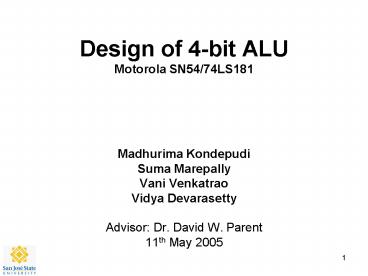Design of 4-bit ALU Motorola SN54/74LS181 - PowerPoint PPT Presentation
1 / 23
Title:
Design of 4-bit ALU Motorola SN54/74LS181
Description:
Title: PowerPoint Presentation Last modified by: Dr. David W. Parent Created Date: 1/1/1601 12:00:00 AM Document presentation format: On-screen Show – PowerPoint PPT presentation
Number of Views:208
Avg rating:3.0/5.0
Title: Design of 4-bit ALU Motorola SN54/74LS181
1
Design of 4-bit ALUMotorola SN54/74LS181
- Madhurima Kondepudi
- Suma Marepally
- Vani Venkatrao
- Vidya Devarasetty
- Advisor Dr. David W. Parent
- 11th May 2005
2
Agenda
- Abstract
- Introduction
- Why
- Simple Theory
- Back Ground information (Lit Review)
- Summary of Results
- Project (Experimental) Details
- Results
- Cost Analysis
- Conclusions
3
Abstract
- Goal is to design a 4-bit ALU driving a load of
30fF in 5ns. - Perform 16 Arithmetic operations.
- Perform 16 Logical operations.
- The data should be transferred at clock rates of
200 MHz, with .6ns setup and hold times. - Maximum power is 50mW.
- Maximum area is 500x500µm2
4
Introduction
- Why this project?
- The Arithmetic and logic Unit is a building
block of several circuits. - Challenging to design a 16 logic level design
working at 5ns. - Design consists of different kinds of logic
Ripple Carry Adder, Subtractor, Transfer Data,
DFF, Decoders, Inv, Nand, Nor, Xor, etc.
5
ALU Block Diagram
6
Function Table
A, B 4 Bit Input, M , S0, S1 Status Control
Pin Cn Carry in
7
Project Summary
- The ALU performs 16 Arithmetic functions and 16
Logical functions at 200MHz. - Uses Ripple carry adder to perform addition.
- Design uses maximum power of 18.9mW
- Maximum area is 403 x 335µm2
8
Design Flow
9
Longest Path
10
Longest Path Calculations
CELL Cint Cg tphl NSN NSP N M R WN WP
F F s cm cm
INV 2.00E-14 3.0000E-14 1.00E-10 1 1 1 1 1.805 5.44E-04 9.81E-04
NOR 2.00E-14 5.1173E-14 1.90E-10 1 2 2 3 2.000 4.96E-04 9.91E-04
NAND 2.00E-14 4.9907E-14 2.20E-10 2 1 3 2 1.000 8.73E-04 8.73E-04
XNOR 2.00E-14 5.8595E-14 4.50E-10 2 2 4 6 1.718 5.81E-04 9.98E-04
INV 2.00E-14 2.6487E-14 1.00E-10 1 1 1 1 1.805 5.07E-04 9.15E-04
NAND 2.00E-14 4.7736E-14 2.20E-10 2 1 3 2 1.000 8.48E-04 8.48E-04
NOR 2.00E-14 5.6913E-14 2.00E-10 1 2 2 3 2.000 4.85E-04 9.70E-04
NOR 2.00E-14 4.8831E-14 1.90E-10 1 2 2 3 2.000 4.81E-04 9.61E-04
NAND 2.00E-14 4.8388E-14 2.20E-10 2 1 3 2 1.000 8.55E-04 8.55E-04
NOR 2.00E-14 8.6127E-14 4.00E-10 1 2 2 3 2.000 4.31E-04 8.63E-04
INV 2.00E-14 2.1723E-14 1.00E-10 1 1 1 1 1.805 4.58E-04 8.26E-04
NAND 2.00E-14 6.4611E-14 2.50E-10 2 1 3 2 1.000 8.19E-04 8.19E-04
INV 2.00E-14 2.7483E-14 1.10E-10 1 1 1 1 1.803 4.51E-04 8.13E-04
INV 2.00E-14 2.1205E-14 1.10E-10 1 1 1 1 1.803 3.94E-04 7.10E-04
Total Propagation delay for the longest path
2.86ns
11
Gate Level Diagram
12
Schematic - Top Level
Schematic- Top-Level
13
Simulation-1(Logical Operations)
F (AB) '
F A'
F (A'B)
F Logical 1
S4, M1, (AB)
F (A XOR B) '
F (AB) '
F AB'
F B'
14
Simulation-2 (Arithmetic Operations)
F AB - 1
F AB'- 1
F minus 1
F A - 1
F A plus (AB)
F A plusB
F AB plus(AB')
15
Layout
16
Verification
DRC Results
NETLISTS MATCH
17
Transient Response
A0, B1, M0, SE, F0 F1F2 F3 0, F AB
plus A
18
Transient Response -Power
Total Power 18.9mW
19
Results
- The ALU performs all 32 functions at a 200MHz
clock and a load of 30fF. - Power dissipation is 18.9mW.
- Area of the layout is 403 x 335µm2
20
Cost Analysis
- Time spent on each phase of the project
- Logic check 1 week.
- Gate level design 2 weeks.
- Integration of schematic blocks and verification
2weeks. - Layout 2 weeks.
- Post extraction check 3 days.
21
Conclusions
- Designed and tested almost all the design units
that we learnt in the class. - Designed a 4-Bit ALU that performs sixteen
arithmetic and sixteen logical functions at
200MHz frequency with setup and hold time 0.6ns,
driving up to 30fF. - This circuit can be used as a building block for
16/32-bit ALU. - The Logic design can be modified to perform more
functions.
22
Lessons Learned
- Uniform cell height.
- No bends in the poly.
- Learned to fix LVS errors using extracted view.
23
Acknowledgements
- Thanks to Cadence Design Systems for the VLSI lab
- Thanks to Professor David W. Parent for his
guidance.































